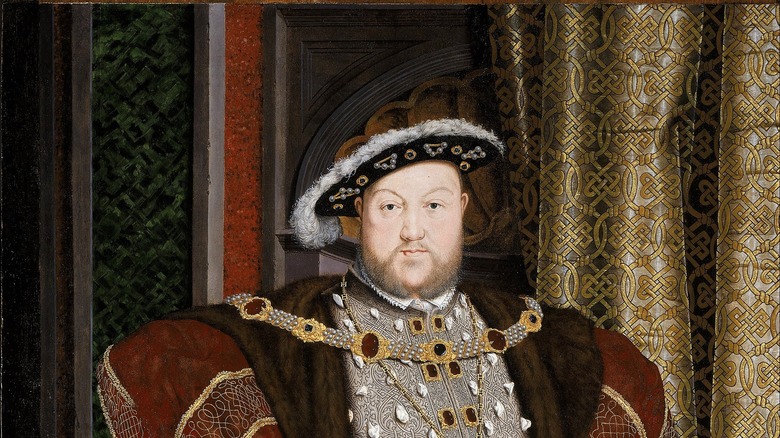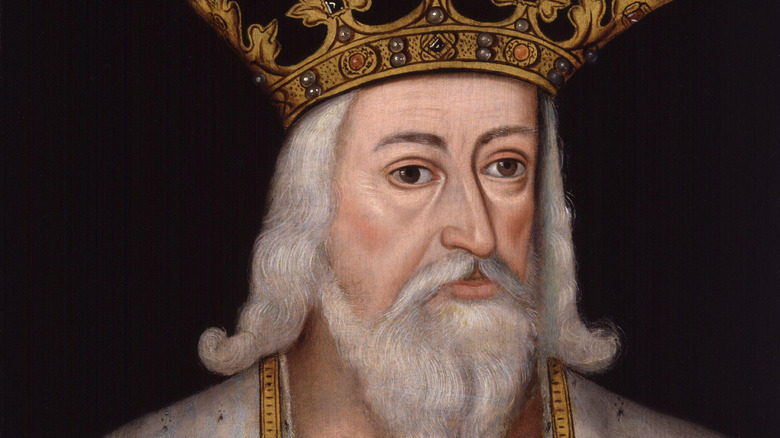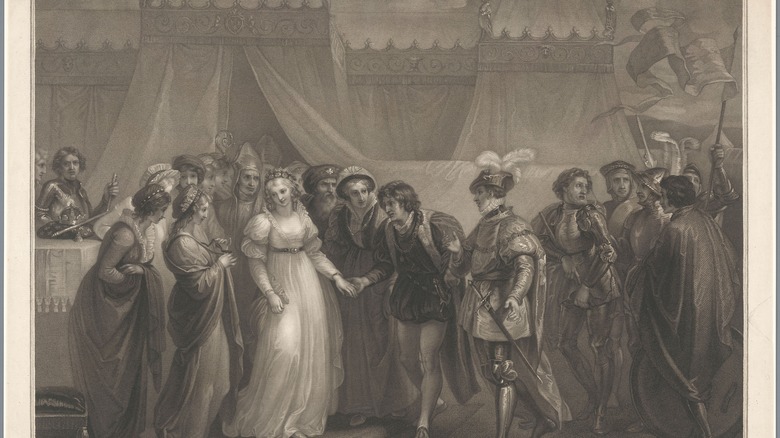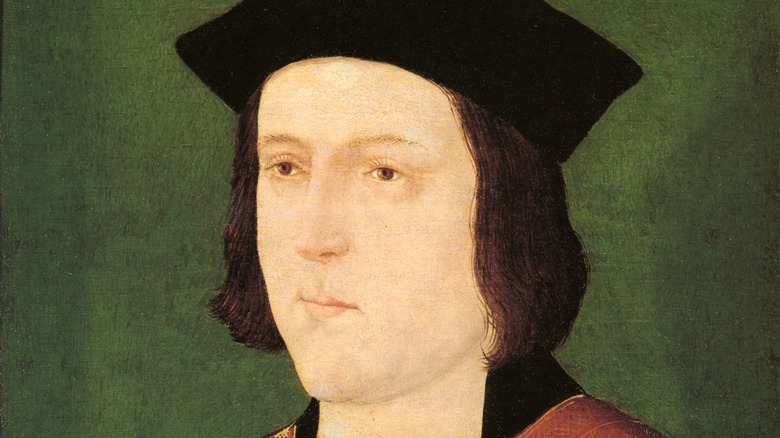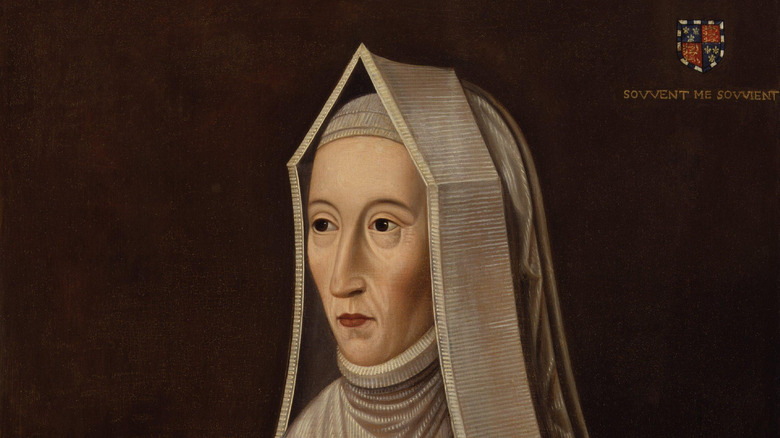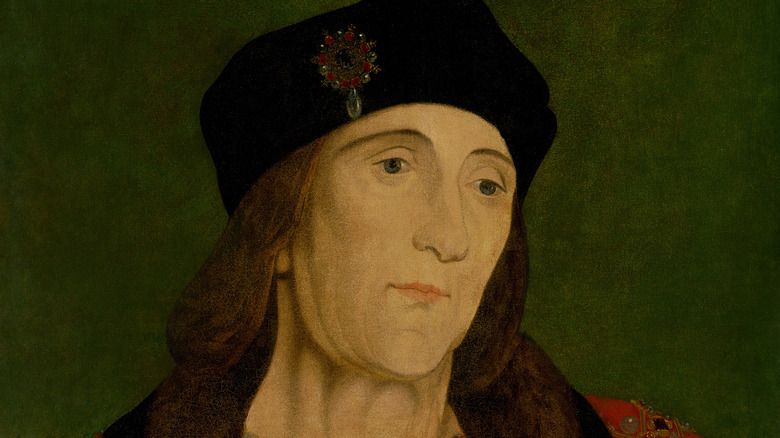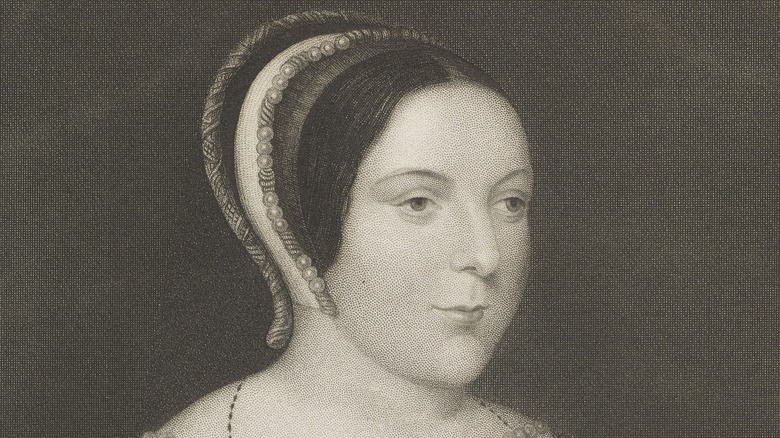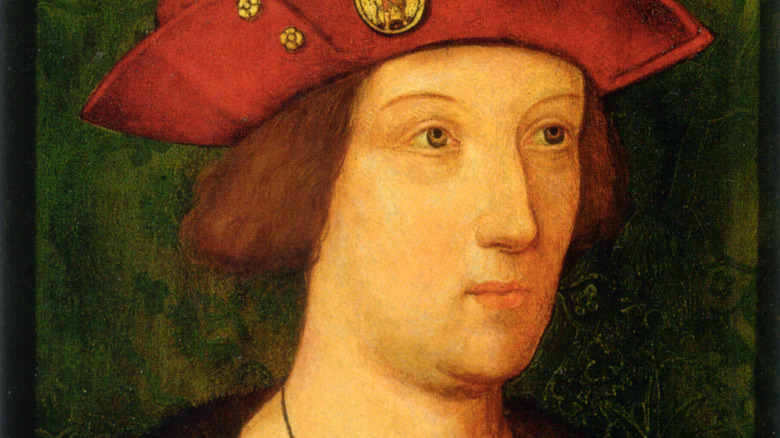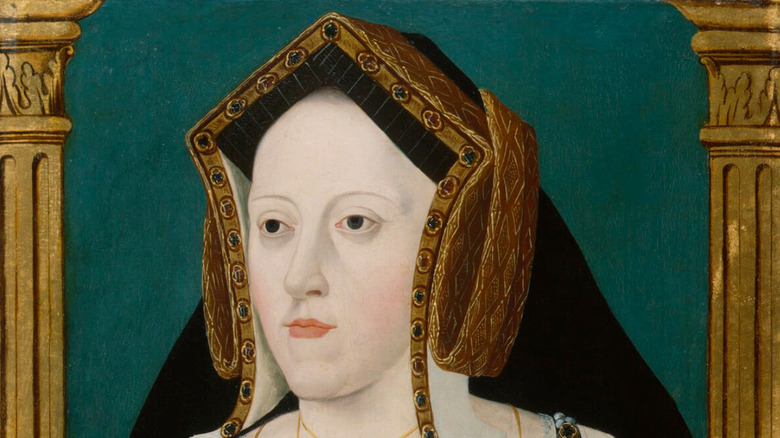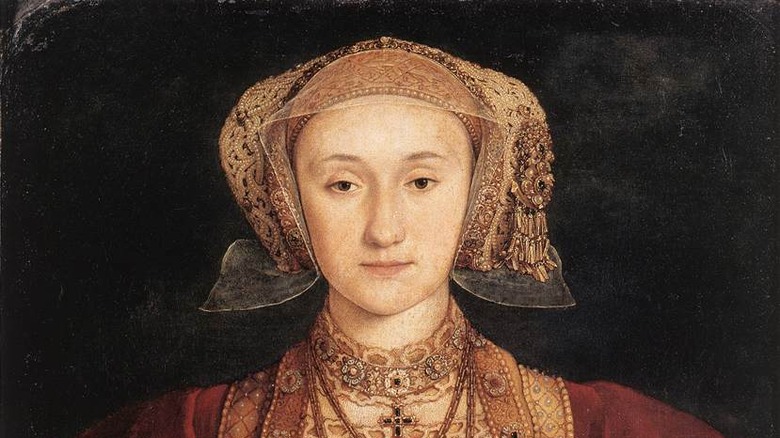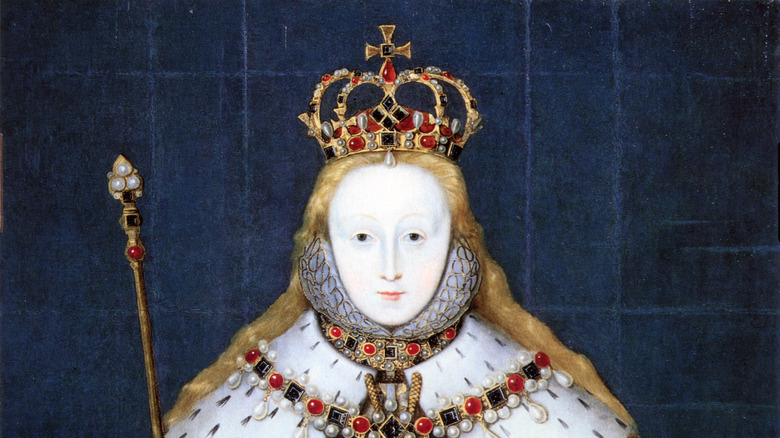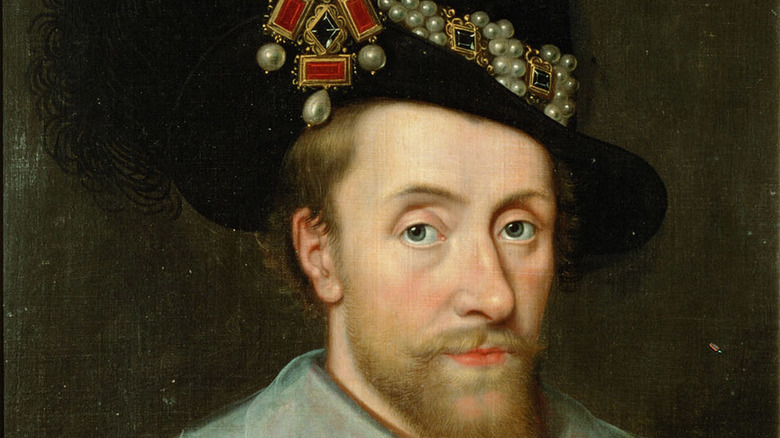Henry VIII's Family Tree Explained
Henry VIII is known for his six wives and for being the father of Elizabeth I, but he's less well-known for his ancestors, despite them being pretty wacky too. Henry is descended from the two families of that long-lived English dynasty, the Plantagenets: the house of Tudor on his father's side and the house of York on his mother's. Both have histories worth exploring.
On his own, Henry brought six women and four children into the family, though one son was illegitimate. Though he had no living grandchildren, his family tree and dynasty continued through his sister Margaret's heirs of Scotland, the house of Stuart, especially as Elizabeth I left the throne of England to her Stuart cousin, James VI of Scotland (via National Museums Scotland).
Henry VIII was the eventual result of several family branches fighting over a throne, and the survivors finally deciding to marry each other and have children. Since Henry VIII was a second son who was never expected to be king, having multiple children proved prudent. Due to the complicated relationships of the Plantagenet line, here is his family tree explained.
Ancestors: Edward III and his sons
King Edward III had several sons, five of whom succeeded to adulthood, none of whom became king of England themselves. However, the squabbles for the throne among their descendants — the Tudors, Yorks, and Lancasters among them — were legendary.
Edward III is best-known for leading England's side of the Hundred Years War with France (via Britannica). By the time the two countries struck a temporary peace in 1375, Edward was in failing health. Two of his sons, Prince Edward and John of Gaunt, became divided and led rival factions in various councils. Ultimately, Prince Edward's son and Edward III's grandson, Richard, became king of England, though he died without children (via the British Royal Family official website). His cousin Henry, son of John of Gaunt and grandson of Edward III, took the throne from him, and his family eventually became known as the house of Lancaster, writes Britannica.
Meanwhile, Edward III's fourth son, Edmund of Langley, was created the first duke of York in 1385, and thus started that line, as per The History Press. His great-grandson was Edward IV, who wrested England back from the Lancasters during the middle of the Wars of the Roses, writes History. Ultimately, the conflict pitted cousin against cousin as everyone fought to either stake a claim or pick a side.
Ancestors: Catherine of Valois and Owen Tudor
Catherine of Valois, widow of Henry V (of the Lancaster branch), had a secret marriage with Welshman Owen Tudor. According to ThoughtCo, it is unclear exactly how they met, or when exactly they were married, though it was definitely by 1432. Catherine's husband Henry V had died years before, and her son Henry VI had presumably little need of her since his coronation. Parliament attempted to forbid Catherine from marrying without either its consent or that of her son in 1428, but she evidently ignored both of them. Catherine had several children with Owen Tudor and died in 1437, in Bermondsey Abbey.
Owen Tudor supported the Lancastrians and Henry VI; he was captured by the Yorks in 1461 and ultimately beheaded, writes World History. Catherine's eldest son with Owen, Edmund, was Henry VIII's paternal grandfather. Edmund went on to marry Margaret Beaufort, and their son, Catherine's grandson, became King Henry VII (via ThoughCo).
When Henry VII won the War of the Roses, he claimed England by right of conquest and his mother Margaret Beaufort's ancestry. Interestingly enough, he didn't draw on his connection to Henry VI through their shared relative Catherine of Valois, a French princess and queen of England. World History notes that through his marriage to Elizabeth of York, rivals Yorks and Lancasters were united, giving rise to the Tudor dynasty for the next century, including Henry VIII.
Maternal grandparents: Edward IV and Elizabeth Woodville
Edward IV, Henry VIII's grandfather, was the head of the York dynasty after the death of his father and older brother at the Battle of Wakefield in 1460, as per English Monarchs. Through a series of decisive battles in the mid-1400s, he won the throne of England from Henry VI, his cousin through their common ancestor Edward III (via World History). Edward IV and his queen, Elizabeth Woodville, had multiple children, including Henry VIII's mother, Elizabeth of York.
Edward IV and Henry VI effectively tossed the crown back and forth between themselves quite a few times throughout the mid-1400s, through various battles and exiles to other countries. Edward IV eventually won the throne and ruled until his death in 1483, writes English Monarchs. Edward allegedly had Henry VI murdered in the Tower of London, notes English Monarchs.
Elizabeth Woodville helped her family's status rise high after her second marriage to Edward IV. After Woodville's daughter, Elizabeth of York, married Henry VII, she retired to Bermondsey Abbey and died there in 1492 (via The History Press). Essentially, Henry VIII was descended from royalty on both sides of his lineage.
Paternal grandparents: Edmund Tudor and Margaret Beaufort
Margaret Beaufort, a great-granddaughter of Edward III by way of his son, John of Gaunt, married Edmund Tudor, son of Catherine of Valois and Owen Tudor, at the age of 12, writes History Today. She gave birth to her only son, the future Henry VII, at the age of just 13, a terrible feat that may have rendered her sterile. Beaufort's ancestors were born before John of Gaunt's marriage but legitimized after his marriage, making her son Henry VII's claim to the English throne particularly tenuous (via History Today).
Edmund Tudor died three months before his son's birth, writes Britannica. Beaufort remarried twice, and her third husband, Thomas Stanley, helped her son Henry VII win the throne at the decisive Battle at Bosworth Field. Stanley's hesitance and ultimate betrayal of Richard III was crucial in Henry VII's ultimate success (via Historic-UK).
After Henry VII became king, Beaufort helped found St. John and Christ's colleges (via Britannica). She carved a space for herself in which she possessed considerable political influence over her son and other prominent figures; this was rather unusual for the time, mainly because she was a woman. She died in 1509, soon after her son's own death.
Parents: Henry VII and Elizabeth of York
After the death of her father, Edward IV, Elizabeth of York's uncle, Richard III, took the throne. As ThoughtCo details, she in essence became a political pawn for a time. Once Richard was killed at Bosworth in 1485, Henry VII took the throne and was betrothed to Elizabeth.
Henry VII was a longshot to win the battle for the throne during the last gasps of the War of the Roses. However, he lobbied hard for supporters and was ultimately successful at the Battle of Bosworth. His marriage to Elizabeth of York helped cement and legitimize his claim to the English throne, since she was the eldest Yorkist princess, writes History Extra. As ThoughtCo notes, their union established the Tudor dynasty, finally bringing together the Yorks and Lancasters and ending the War of the Roses.
Henry VII used his children to build ties to the rest of Europe and to maintain peace. For example, his son, Arthur, was married to Catherine of Aragon (via ThoughtCo), and his daughters to the kings of Scotland and France, according to the British Royal Family website.
Elizabeth of York died several days after childbirth in 1503, and Henry VII died six years later. Their son, Henry VIII, therefore inherited the throne directly from his father that same year. Interestingly enough, Elizabeth of York's image is usually used for the queen card in standard card decks, as per ThoughtCo.
Siblings: Margaret and Mary
Henry VIII's older sister Margaret was queen of Scotland until 1513, when her husband, James IV, was killed (via Britannica). She then served as regent for her son, James V, who was the only one of their six children to survive infancy (via The History Press). Margaret would go on to marry twice more and have a daughter with her second husband as well. Unfortunately, neither of her two later marriages proved happy, writes The History Press. Margaret died in 1541. One of Margaret's granddaughters was Mary, Queen of Scots, who was executed by her cousin Elizabeth I, writes official website of the British Royal Family.
Henry VIII's younger sister Mary was queen of France for three months before marrying Henry's friend Charles Brandon. Despite Henry asking Charles not to propose to Mary, she convinced Charles otherwise, and the pair married in 1515, writes Britannica. As The History Press notes, this was treason, but Henry VIII ultimately forgave them, thanks to some money changing hands, according to Britannica.
Mary died in 1533. One of her granddaughters was Jane Grey, who was queen of England for nine days in 1553, following the death of Henry VIII's son, Edward VI (via Historic-UK).
Siblings: Elizabeth and Arthur
Henry VIII's sister, Elizabeth, only lived until the age of 3, according to ThoughtCo, while his older brother Arthur, prince of Wales, lived until 15, writes English Monarchs.
Arthur was married to the Spanish princess Catherine of Aragon, but his sudden death just months after their wedding left her widowed — and a primate candidate for the infamous king. The two married severak years after Arthur's death, in 1509, writes Biography, after she insisted that the marriage never was consummated.
Ultimately, despite not living very long, Arthur had a prominent impact on Henry VIII's early marriages and his decision to break away from the Catholic church (as they refused to grant Henry VIII's annulment from Catherine) and found the Church of England.
Wives: Catherine of Aragon, Anne Boleyn, Jane Seymour
Henry VIII was married to Catherine of Aragon for 24 years, reports the Smithsonian. And she as instrumental in defeating Scotland in the 1513 Battle of Flodden, commanding England's armies while the king was at war with France. In a letter alerting Henry of the victory, she sent along a piece of the Scottish king's surcoat, though she wanted to send the dead man's body originally, notes Agnes Strickland in "Lives of the Queens of England."
The couple would many children who didn't live, and eventually Henry grew tired of Catherine. After quietly marrying Anne Boleyn, Henry VIII had his and Catherine's marriage annulled by his own archbishop, becoming head of the Church of England in the process (via Biography). She died at the age of 50, in 1536.
Anne Boleyn began to spend more time with the king in the late 1520s; they married in 1533. Though she gave him a daughter, Elizabeth I, Boleyn also had several stillbirths, and Henry eventually pushed for her execution in 1536, writes Biography.
Jane Seymour, Henry's third queen, was from an English family and served as a lady-in-waiting for both Catherine and Boleyn. She and Henry married the same month Boleyn was executed, writes Biography. After finally giving him his longed-for son, the future Edward VI, Seymour died just a few days later, luckily for her before Henry could grow tired of her.
Wives: Anne of Cleves, Catherine Howard, Catherine Parr
After Jane Seymour's untimely death, Henry VIII spent the next few years looking around Europe for which woman he could marry next. He settled on Anne of Cleves but annulled his marriage to her within six months, partly due to her not being as pretty as expected, writes Historic Royal Palaces. Ultimately, Anne of Cleves made out the best of all his wives, being granted various estates and an allowance. She outlived Henry and died in 1557 (via Westminster Abbey).
Henry VIII then married Catherine Howard, who, like Anne, was much younger than him. Howard had also served Anne of Cleves as one of her maids of honor at court (via Britannica). Just over a year later, in 1542, Howard was executed for adultery. Recent research has shown that she was likely aware of her sexuality — and the power that it brought her — early on, at a time when this wasn't positive for women (via History Press).
By this point, Henry had suffered from long-standing leg ulcers, was obese, and in failing health, writes Historic-UK. It was fairly clear there would be no other children in his future. Finally, he married Catherine Parr, and she nursed him through the last years of his life. She also outlived him, since Henry died in 1547. She was a patron of the arts and wrote her own books. Sadly, Parr died in childbirth in 1548, after having married her true love, Thomas Seymour, writes Historic Royal Palaces.
Children: Henry, Mary, Elizabeth, and Edward
Henry VIII had an illegitimate son, also called Henry, who died at the age of 17, likely of tuberculosis, writes Historic Royal Palaces.
Edward, the youngest of Henry's children, ruled after his father for just six years. He died in July 1553 and left the throne to his cousin, Jane Grey, who was a Protestant like himself, writes History, as opposed to a Catholic like his half-sister Mary. Jane was able to hold the throne for just over a week before Mary rallied her own popular support and took the throne.
Henry VIII's daughters, Mary and Elizabeth, were 17 years apart, and as queens of England, their reigns were, in turn, very different. Mary attempted to turn the country back towards Catholicism and had hundreds of Protestants killed, according to History. She ruled for five years and died in 1558. Elizabeth, meanwhile, led England through its Golden Age, defeating the Spanish armada in the process (via Historic-UK). She was also a patron of the arts, most notably the playwright William Shakespeare (via History).
Ultimate heir to the Tudors: James I
When Elizabeth I died with no children, her cousin, James of Scotland, became her heir (via National Museums Scotland). He ruled as James I in England and began the Stuart (or Stewart) dynasty. James was therefore Henry VIII's great-grandnephew.
James was crowned in 1603 and died in 1625. He had several children, though only three of them survived to adulthood, as per World History Encyclopedia. His second son, Charles, assumed the throne upon his father's death. And his daughter Elizabeth's descendants eventually took the English throne back as the Hanoverian line.
James' reign was overall known for stability, though it was of a precarious nature. Jamestown was founded in his name, and the Mayflower sailed to Plymouth while he was king. He was also a patron of the arts and the authorizer of the King James Bible. His reign was notable for uniting the crowns of England, Scotland, and Ireland for the first time, as per World History Encyclopedia.
